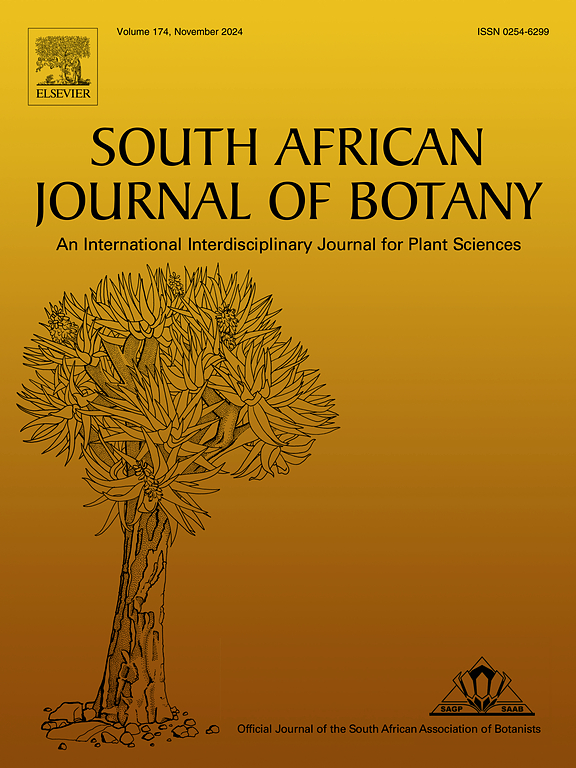Mitigating the adverse effects of salt stress in pepper plants using two native strains: Cellulosimicrobium 60I1 and Pseudomonas 42P4
IF 2.7
3区 生物学
Q2 PLANT SCIENCES
引用次数: 0
Abstract
Soil salinity is one of the main abiotic factors causing plant stress and is a major cause of land degradation worldwide, especially in arid and semi-arid regions. High salinity in the root zone has a negative effect on most plant functions, limits biomass accumulation and significantly reduces crop productivity. The use of plant growth promoting rhizobacteria (PGPR) to enhance crop growth under saline conditions is an alternative to reduce chemical fertilization and the negative symptoms caused by salinity. The objective of this study was to evaluate the inoculation effect of Cellulosimicrobium 60I1 and Pseudomonas 42P4 on pepper plants grown under salinity stress. Pepper seedlings cv. Calafyuco INTA inoculated with both strains were grown under greenhouse conditions. Twenty-five days after inoculation, they were transplanted into plastic pots and treated with 100 mL of 150 mM NaCl or 100 mL of 200 mM Na2SO4 solutions, to induce the salt stress. A completely randomized design of nine treatments was established (three levels of the salt stress factor: without salt, NaCl and Na2SO4 per three levels of the bacteria factor: without PGPR, 60I1, 42P4). Seventy-five days after the sowing, morphological, physiological, and biochemical changes, including a profile of phenolic compounds, were evaluated. The results demonstrated that salt treatments, decreased the height (26–32 %), stem diameter (20–36 %), leaves per plant (22 %-non significant), root length (26–45 %), SPAD index (36–27 %), root and shoot dry weight (51–51 %), and survival percentage (20–100 %) of pepper plants grown in the greenhouse (with NaCl and Na2SO4, respectively). However, the inoculation with 42P4 increased root (76–58 %) and shoot dry weight (108–98 %); whereas 60I1 increased (60–35 %) and (95–92 %) with NaCl or Na2SO4, respectively, compared to the control without PGPR in plants grown under salinity stress conditions. Inoculated plants increased tolerance to salt conditions by reducing lipid peroxidation and increasing chlorophyll quantum efficiency, carotenoids, anthocyanins, and nitrogen levels. In addition, salt stress modified the phenolic compound profile and the inoculation maintained the levels of some compounds with antioxidant activity at levels similar to that of the unstressed control. This work highlights the importance of PGPR as an alternative to increase salt stress tolerance in crops in the context of climate change.

利用两种本地菌株:纤维素微生物60I1和假单胞菌42P4缓解盐胁迫对辣椒植株的不利影响
土壤盐分是引起植物胁迫的主要非生物因子之一,是世界范围内土地退化的主要原因,特别是在干旱和半干旱地区。根区高盐度对植物的大部分功能有负面影响,限制了生物量的积累,显著降低了作物的生产力。利用促进植物生长的根瘤菌(PGPR)在盐碱条件下促进作物生长,是减少化学施肥和盐碱引起的负面症状的一种替代方法。本研究旨在评价盐胁迫下纤维微生物60I1和假单胞菌42P4对辣椒植株的接种效果。辣椒苗cv。在温室条件下,接种了这两种菌株的Calafyuco INTA进行了生长。接种25 d后移栽于塑料罐中,分别用100 mL 150 mM NaCl或100 mL 200 mM Na2SO4溶液处理,诱导盐胁迫。建立9个处理的完全随机设计(盐胁迫因子3个水平:无盐、NaCl和Na2SO4;细菌因子3个水平:无PGPR、60I1、42P4)。播种后75天,对包括酚类化合物在内的形态、生理和生化变化进行了评估。结果表明:盐处理使温室辣椒株高(26 - 32%)、茎粗(20 - 36%)、单株叶片(22%)、根长(26 - 45%)、SPAD指数(36 - 27%)、根、梢干重(51 - 51%)和成活率(20 - 100%)分别降低(NaCl和Na2SO4)。接种42P4后,根重增加76 ~ 58%,茎干重增加108 ~ 98%;在盐胁迫条件下,60I1在NaCl和Na2SO4处理下的表达量分别比不加PGPR的对照增加了60 - 35%和95 - 92%。接种后的植株通过减少脂质过氧化和增加叶绿素量子效率、类胡萝卜素、花青素和氮水平提高了对盐条件的耐受性。此外,盐胁迫改变了酚类化合物的分布,接种使一些具有抗氧化活性的化合物的水平保持在与未胁迫对照相似的水平。这项工作强调了PGPR作为在气候变化背景下提高作物耐盐性的替代方案的重要性。
本文章由计算机程序翻译,如有差异,请以英文原文为准。
求助全文
约1分钟内获得全文
求助全文
来源期刊

South African Journal of Botany
生物-植物科学
CiteScore
5.20
自引率
9.70%
发文量
709
审稿时长
61 days
期刊介绍:
The South African Journal of Botany publishes original papers that deal with the classification, biodiversity, morphology, physiology, molecular biology, ecology, biotechnology, ethnobotany and other botanically related aspects of species that are of importance to southern Africa. Manuscripts dealing with significant new findings on other species of the world and general botanical principles will also be considered and are encouraged.
 求助内容:
求助内容: 应助结果提醒方式:
应助结果提醒方式:


